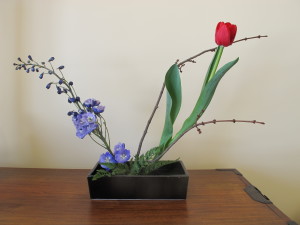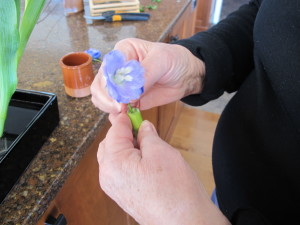Ikebana: Arranging Flowers in a Japanese Artform
Some people collect salt and pepper shakers, others license plates or stuffed teddy bears. I collect different species of flowers that I grow in my garden. Although I lost track long ago, I grow well over 100 species and varieties of flowers, probably over 200. If I see something new at a green house, I have to try it. I love them outdoors, but most I grow so that I can have flowers in the house. I love to make flower arrangements, and have been doing it for decades.
Recently I met with Joanne Wise of Grantham, NH to learn about a Japanese way of arranging flowers, an art form called Ikebana. Joanne lived in Tokyo for four years and apprenticed under an Ikebana master. I brought a generous bouquet of cut flowers with me, and Joanne provided the expertise, containers and frogs (which are heavy objects with sharp needles poking up to hold flowers in place in a vase).
Joanne explained that there are at least nine schools of Ikebana in Japan, and that she was trained in one called Sogetsu. Ikebana developed in the fourteenth to sixteenth centuries when shoguns (feudal leaders) ordered certain artists to create flower arrangements to bring natural beauty indoors, infusing nature to their palaces. Over time, different styles have developed.
According to Joanne, Ikebana arrangements should have strong lines, usually created by branches, often bare branches. Arrangements also include flowers, of course, but are generally very simple. Some styles use stone and water or even sand as part of the arrangement, often in a simple low bowl.
My first arrangement under Joanne’s supervision was in a low Ikebana bowl, a ceramic rectangle about two and a half inches deep. I placed a frog in the middle and then selected two bare branches, which I pinned in place on the frog. I cut the ends of the branches at an angle so that I could more easily push them onto the needles of the frog. A straight cut produces a round cross-sectional cut, but one on a 45 degree angle yields a nice oval with more space to grab the upward facing pins of the frog.
Each branch was placed at an angle of about 30 to 45 degrees off vertical – and the second branch was roughly parallel to the first. Next I placed a stem of delphinium going off in the opposite direction. I stripped off the lower blossoms from the stem, which served to establish a strong visual line. Later I used the blossoms I had taken off to help hide the frog in the bowl.
Simplicity is an important component of Ikebana, so I added just one bright red tulip. The tulip wove its way through the two bare sticks, adding a punch of color. I left the leaves on because they added a simple splash of green. Joanne removed a bit of fern frond that came free with the flowers and used it in the base of the arrangement to help cover the frog.
Getting flowers and sticks to stay in place in an arrangement can be difficult. Joanne taught me some nifty tricks that I will use in arrangements – whether Ikebana or conventional.
The first trick is how to attach a narrow stem to a frog. It’s impossible to do if the stem is smaller than the needle, or nearly so, which is often the case. Joanne showed me how to use a one-inch piece of stem from a tulip or daffodil (or other fat, juicy stem) to create a sleeve that can hold a thin stem inside it. She just poked a tooth pick into the tulip stem, making a small hole that allowed her to insert the thin stem of a single delphinium blossom inside the tulip stem. The tulip stem, along with the blossom, was easily attached to the frog.
One arrangement we created was in a tall narrow ceramic vase which precluded using a frog in the bottom to hold stems in place. When Joanne wanted to keep 2 sticks together in that arrangement, she used a narrow Velcro strip as a fastener. She tied the sticks together down low, so that the ceramic vase hid the Velcro but the sticks stayed close together.
Joanne uses many different kinds of flowers in her arrangements, but only a few at a time. Some flowers that work well in Ikebana include Siberian iris, alstroemeria, tulips, Irish bells, forsythia, goose-necked loosestrife and chrysanthemums. I prefer to work with flowers like lisianthus or chrysanthemums that will last a week or more in an arrangement, but also appreciate iris and tulips that might only last a few days. Tulips, by the way, will move in an arrangement, bending or twisting their stems – sometimes in opposition to the laws of gravity.
Trying to define Ikebana is, for me, a bit like trying to define love, a fabulous meal or a great bottle of wine. You can describe the ingredients, but there has to be a chemistry that makes it work. As I see it, simplicity and elegance are keys to Ikebana. A lack of clutter is important. Joanne made one arrangement using 2 tulips and a stem of loosestrife in an urn-shaped blue vase with a narrow neck. It could be considered Ikebana, or just a simple conventional flower arrangement.
On another note, go outside today and notice where the snow has melted off the ground first near your house. That is where you should plan on planting early-blooming spring bulbs next fall. Take a photo or place a plastic marker to remind yourself next fall. We all need flowers as soon as we can get them.
Henry’s book, The New Hampshire Gardener’s Companion is just out in a second edition with 2 new chapters and updated material, including pests and diseases common in New England.





